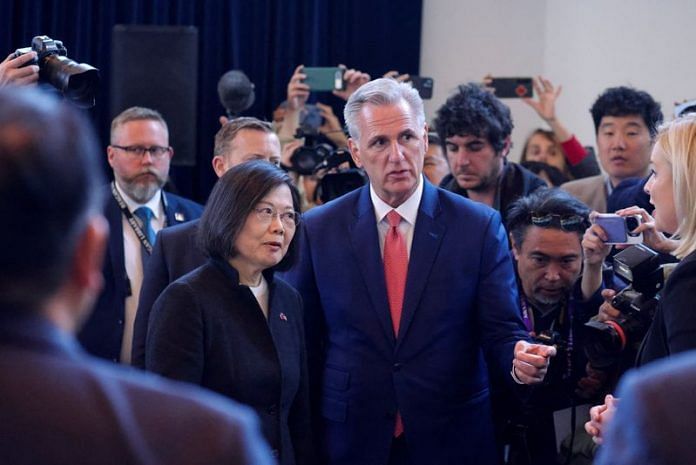Beijing’s calculated military response to Taiwanese President Tsai Ing-wen meeting with US House Speaker Kevin McCarthy in California didn’t create a splash on Chinese social media. The ‘Joint Sword’ exercise launched from 8-10 April failed to achieve a complete blockade of Taiwan. President Xi Jinping was likely trying to balance presenting himself as peacemaker-in-chief and defending China’s ‘national sovereignty’ over Taiwan.
Aircraft sorties were again hovering over the Taiwan Strait, as we saw during last year’s Taiwan visit by Nancy Pelosi. Beijing was waiting for President Tsai to return to Taipei to announce the ‘Joint Sword’ exercise.
But there are several differences between Beijing’s response to the two Taiwan-US contacts.
Precision attack simulation
On 8 April, the PLA sent 71 aircraft and 9 PLA Navy vessels across the Taiwan Strait, of which 45 aircraft crossed the median line. If that wasn’t enough, on 10 April, the PLA set a record by sending 91 aircraft across Taiwan Strait, 54 of those crossed the median line. During the exercise, PLA deployed J-16s and J-10C fighter jets and Y-8 anti-submarine aircraft crossing the median line multiple times over the three-day exercise.
The military exercise launched to simulate a blockade around Taiwan during Pelosi’s visit lasted four days instead of the three days announced as part of the ‘Joint Sword’ exercise after Tsai’s visit to the US.
Another stark difference was the PLA deploying the Shandong aircraft carrier near Taiwan Island.
Taiwan’s Ministry of Defence said the PLA carrier take-off and landing drills on Sunday from Chinese aircraft carrier Shandong were extremely close to Japan’s territorial waters. The situation was unprecedented as Japan had to scramble jets in response.
“We confirmed approximately 120 landings and departures on the Chinese navy’s Kuznetsov-class aircraft carrier Shandong, 80 times by fighter aircraft and 40 times by helicopters,” said Japan’s Self-Defense Forces on Monday.
On Sunday, the PLA tested the capability of the J-15 aircraft to take off and land from the Shandon aircraft carrier, which departed from Sanya Naval Port in the Chinese province of Hainan earlier in April. A 17-ship fleet of the PLA Navy participated in the exercise.
On Haokan Baidu, a short video-sharing platform, the most viewed video on Monday went with the title “For the first time, the Shandong ship participated in the combat readiness patrol around Taiwan and the ‘Joint Sword’ exercise”. The video was viewed more than 2 million times.
Taiwanese experts noted the significance of deploying the Shandong carrier east of Taiwan. “The drills show that the Shandong aircraft carrier is now a serious threat to eastern Taiwan, which Taiwan’s military has traditionally used to preserve and maintain its combat readiness in the event of a full-scale invasion by the PLA since the region is protected by the central mountain range on the west,” said retired Air Force Lieutenant General Chang Yen-ting.
Besides the deployment of Shandong, the Rocket Army displayed its ability to carry out precision strikes at multiple locations around Taiwan Island. During the exercise, the Rocket Army appears to have tested PHL-191 multiple rocket launchers and DF-11 conventional ballistic missiles, which landed around Taiwan Island at multiple locations.
The Eastern Theatre Command published a simulation showing missiles dropping over Taiwan’s two most populous cities – Taipei and Kaohsiung. It was a gory psychological operation to deter further political contact between Taiwan and the US. Beijing is unlikely to carry out such an attack on Taiwan’s cities.
The ‘Joint Sword’ operation also involved the nuclear-capable bomber H-6K – with missiles on display – completing PLA’s message to deter the US support for Taiwan.
Also read: After Saudi-Iran, China wants to displace America. But won’t be ‘policeman of the world’
The other message
But a myriad aspect of the ‘Joint Sword’ exercise was that the propaganda machinery in China didn’t project the military exercise on Chinese social media as prominently as it did during the Pelosi visit. The ‘Joint Sword’ exercise didn’t trend on Weibo – a Twitter-like Chinese social media platform – unlike the Pelosi visit when Weibo was flooded with news about the PLA’s simulated blockade of Taiwan.
The missing social media chatter could be attributed to Xi’s interest in avoiding riling up the domestic sentiment to preserve Beijing’s newfound interest in peace-brokering.
Kevin McCarthy’s visit to Taipei may have been delayed but that doesn’t mean other senior officials have refrained from visiting the Island nation.
The US House Foreign Affairs Committee chairperson Michael McCaul and Arkansas Representative French Hill landed in Taipei on 8 April. The two discussed the possibility of providing Taiwan with a cutting-edge Starlink satellite system.
The continued contact between the US and Taiwanese officials will likely bring Beijing’s ire back onto the Taiwan Strait, but that doesn’t mean every visit will elicit the same response. Beijing treats certain high-level meetings between Taiwanese and the US side more seriously than others.
Beijing is signalling a relative calm by courting a section of Kuomintang Party’s leadership, but the risk of military escalation remains.
Xi Jinping and his top leadership may not have made up their mind about conducting a full-scale invasion, but the PLA continues to enhance its capability in all four domains of Taiwan Contingency. The latest three-day exercise shows that the potential for a crisis can be just around the corner.
The author is a columnist and a freelance journalist. He was previously a China media journalist at the BBC World Service. He is currently a MOFA Taiwan Fellow based in Taipei and tweets @aadilbrar. Views are personal.
(Edited by Prashant)



